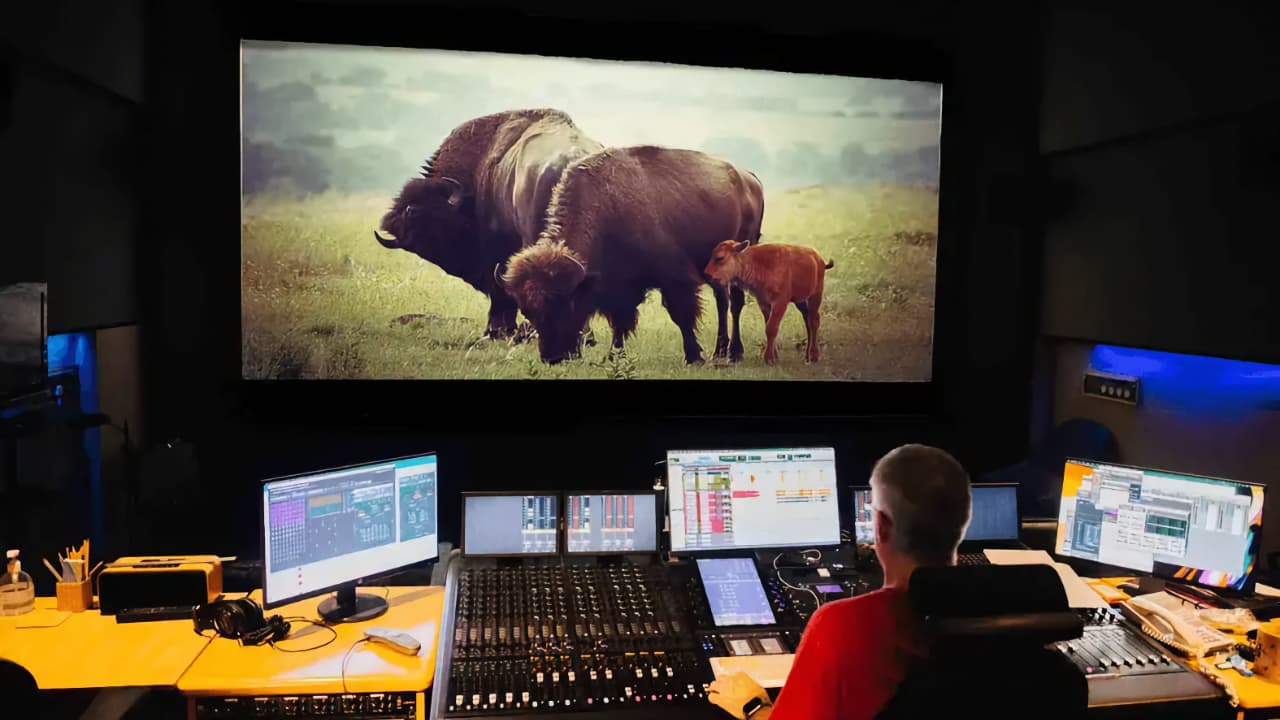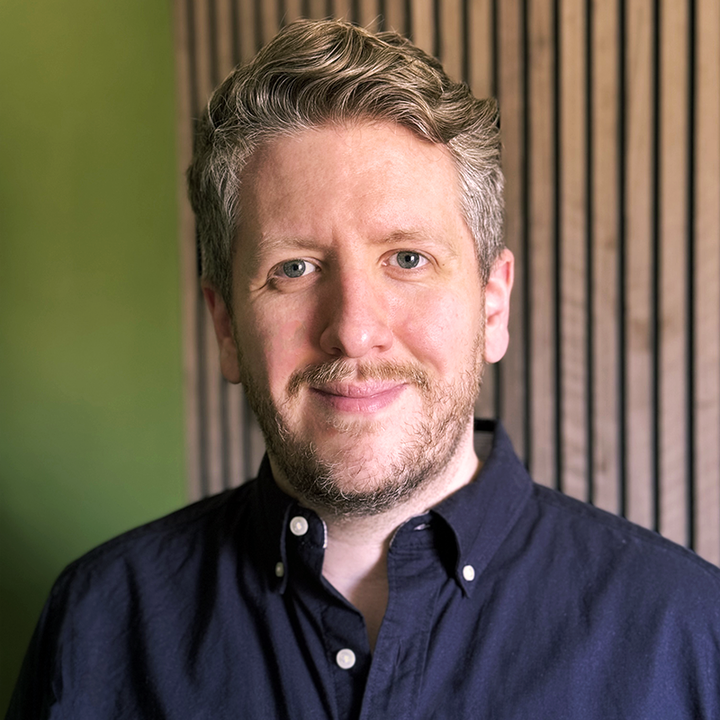
Wounded Buffalo Sound Studios' Jim Jacobs and Ben Peace reveal the technology and techniques behind creating natural history's most iconic soundscapes.
Ever wondered why that majestic bird soaring across your screen in Planet Earth III sounds so... well, majestic? Here's a fun fact for you—it probably doesn't make a sound at all. At least, not on camera.
If you check the raw footage, you’d likely only hear the whirring of helicopter blades or a cameraman saying, “Oh… oh wow… I… wow, would you look at that? Are we getting this, Tim? Tim? Are we… okay, good.”
Enter the niche yet vital art of natural history sound design by the folks at Wounded Buffalo Sound Studios in Bristol, England.
Hans Zimmer, RAYE, and Bastille work for a trailer, but in the documentary you want to hear the real thing
"Most things are filmed on very long lenses," explains Ben Peace, veteran mixer at Wounded Buffalo. "So, you can film something from 400 yards away, but you can't easily capture the sound from that distance."
That's putting it mildly. Most of the breathtaking footage that makes it into shows like Planet Earth III, Earthsounds, and Our Great National Parks arrives at their studio with about as much audio as a mime convention. And that's where the fun begins.
The art of audio authenticity
When you're recreating the sounds of nature, you can't just wing it. Each layer of audio needs to be meticulously researched and verified. As studio manager Jim Jacobs puts it, "The wrong bird at the wrong time of day can ruin the authenticity."
This means rebuilding entire soundscapes from scratch while ensuring every chirp, rustle, and splash would pass muster with a team of eagle-eared scientists. Sometimes literally, when an expert is needed to make sure that particular species of toucan makes that particular sound in that particular part of the Amazon at that particular time of day.
This is where their Pro Tools HDX system earns its keep. Working across multiple dubbing theaters—each equipped with wall-to-wall speakers and Avid S6 M40 consoles—the team pieces together these sonic puzzles layer by meticulous layer. Sometimes, they get lucky.
"We'll get atmospheric sound if we're fortunate," Peace explains. "They might leave a remote camera with a built-in mic somewhere, and even though the sound can be pretty terrible, it's really useful. It lets us know what we're supposed to be aiming for."
Think of it as an audio reference card —not something you'd want in your final mix, but invaluable for authenticity.
 One of the Wounded Buffalo suites, editing audio for some non-wounded buffalo
One of the Wounded Buffalo suites, editing audio for some non-wounded buffalo
The real wizardry happens in their sound editing suites. Here, iZotope RX becomes their secret weapon, helping isolate and preserve those precious moments of genuine wildlife audio that make it back from the field. Every salvageable clip becomes another track in their library of authentic natural sounds.
It’s a challenge at the best of times, but sometimes something near impossible will show up. First-ever footage. Those jaw-dropping moments where we're seeing something never before captured on film. No reference point. No existing recordings. Sometimes, not even scientific descriptions of what these creatures should sound like.
The process becomes part sound design, part scientific research, and part detective work. They're not just checking if a sound is accurate; they're building a complete acoustic profile of an environment. What's the density of the forest? How would that affect sound propagation? What other species would be active at that time?
It’s equal parts science and creativity, all in one audio lab.
Diving deep (literally)
Of course, it’s not just the skies above and the world around us that need some auditory assistance. There’s the briny deep beneath, as well.
"Underwater stuff is actually quite tricky," Jacobs explains. "Swimming generally doesn't make much noise, but when you see it, it kind of needs to make a sound to look right."
A dolphin glides past the camera; viewers expect to hear something. It's a delicate balance between reality and expectation, truth and storytelling.
The physics of underwater sound is its own beast entirely. Sound travels faster and further. It bounces off things in ways that would make your head spin. But Wounded Buffalo has tricks.
Their Dolby Atmos setup isn't just for making things sound pretty. When you're dealing with underwater scenes, that extra dimensionality becomes crucial. Sound doesn't just move left to right down there—it moves in spheres, waves, and patterns that regular stereo can't capture.
"If you're underwater and a dolphin swims past the camera and above you," Jacobs notes, "you can follow it with sound."
Simple words with a complex execution. It takes their entire technical arsenal: a Pro Tools HDX system, a carefully calibrated Atmos setup, and more plugins than a guitar convention. Sometimes, it's pure sound design. Sometimes, it's heavily processed recordings. Sometimes, it's a bit of both. Always, it's an art form.
The tech behind the magic
Don't worry; I know what you're here for. You want the audio tech. Let's break it down.
Dubbing Theaters
Dubbing Theatre A is the crown jewel. It has wall-to-wall speakers powered by a Pro Tools HDX system that would make most studios blush. The HDX card itself is a powerhouse with 18 TI processors running at 350 MHz, pumping out 6.3 GHz of aggregated processing power. When you're trying to recreate a rainforest at dawn, you need voices—lots of them. Each card can handle up to 256 simultaneous tracks at 48 kHz, all with a barely-there 0.7ms latency.
At the heart of the room sits the S6 M40 console, with up to 64 premium TKD faders in a single setup, each channel strip loaded with up to nine assignable knobs. And that's just for starters. The fully modular surface can handle up to 46 different modules—Faders, Knobs, Process, Joystick, Post, and Displays—all customizable to whatever workflow you need.

Need more? The system can expand to support three operators simultaneously, tripling those numbers. That's 192 faders, 138 modules, and enough processing power to mix a small planet.
Plus, it can control up to eight workstations simultaneously. Because when you're juggling multiple nature documentaries and Sir David's waiting for the mix, you need that kind of flexibility.
Theatre B is no slouch, either. Another S6 setup, perfectly calibrated for when A is running full tilt with the latest Planet Earth epic.
Then there's Theatre C, which features Twin Avid S1 modules paired with an Avid Dock. It's the baby of the family, but don't let that fool you.
"When the S6 came along, we jumped ship and went to Avid," Peace recalls. "It's very versatile. It's good at keeping your eggs in one basket with integration."
Edit suites
There are six of them, each running Pro Tools and handling the complex audio restoration and mixing tasks that natural history demands.
iZotope RX isn't just part of their workflow—it's practically a religion. The Advanced version gives them the full arsenal: eight-speaker transcription with color-coded lanes, Dynamic Adaptive De-hum that can track and eliminate complex frequency changes (perfect for those persistent generator hums), and Spectral Recovery that can reconstruct missing frequencies in poor field recordings.
When you're trying to salvage that one perfect recording of a rare bird call from beneath the sound of a helicopter, this software is your savior. It can identify and isolate up to eight speakers in a single recording.
The Text Navigation feature also lets you search through spoken content like a document to find that crucial moment in hours of footage. It’s not perfect, but when you're working with field recordings from the depths of the Amazon, perfect isn't what you need—usable is.
Of course, every suite is equipped for Dolby Atmos work. Because when you're recreating the sound of a rainforest canopy, stereo just doesn't cut it anymore.

Tech Specs and Rundown
Pro Tools HDX
- Each card packs 18 TI processors at 350 MHz
- (6.3 GHz aggregated)
- Voice count: 256 voices per card at 48 kHz
- (scalable up to 768 with three cards)
- Processing depth: 32-bit floating point
- Mixer depth: 64-bit floating point
- Latency: 0.7ms
- I/O channels: 64 channels of DigiLink I/O per card (up to 192 with three cards)
- Automatic Delay Compensation: Up to 16,383 samples
S6 M40
- Up to 64 premium TKD faders in a single-operator setup
- expandable to 192 faders for three operators
- Up to 46 modules per operator (up to 138 with three operators)
- Up to nine knobs per channel
- Up to eight simultaneous workstation connections
- Multiple touchscreen modules
- Dedicated Process Module for function assignments
- Supports Display Modules
iZotope RX Advanced
- Eight-speaker recognition
- Dynamic Adaptive De-hum
- Spectral Recovery for both high and low frequencies
- Text Navigation with search functionality
- Color-coded speaker "lanes" above spectrogram
- Fuzzy search capability for transcribed content
- Real-time transcription capabilities
- Advanced noise reduction toolset
It’s a bittersweet (nature's) symphony, this life
All those perfectly calibrated systems running in perfect harmony are tools. And tools need artists.
Speaking of artists, Peace's journey to becoming a natural history sound maestro isn't precisely what you'd expect from someone who spends their days making penguins sound perfectly penguin-y. "I started messing around with DJing raves back in the 90s."
From bass drops to bird calls. From sweaty warehouses to pristine mixing rooms. Life's funny like that.
Jacobs' path was even more circuitous. Before finding himself at the helm of one of the most sophisticated audio facilities in natural history production, he was... well, let's let him tell it:
"I started as a runner in post-production, worked my way up to being a post manager in London, specialized in audio..."
Between then and now, he's upgraded entire audio departments, designed studios from the ground up, written music for TV, and - because why not - restored pianos. Each step adds another layer to his understanding of sound, music, and how audio shapes our perception of the world.
The future sounds pretty good
"We're constantly evolving," Jacobs says. And he means it. They're already quoting for theatrical work, pushing their Atmos capabilities to the limit, and exploring new ways to make nature sound more... well, natural.
The complexity of it all is massively ironic. Incredibly expensive niche equipment, years of development, countless hours of calibration—just to make a bird sound like a bird.
But when that bird soars across an IMAX screen, and the entire audience holds their breath? It's worth it.
These days, Wounded Buffalo is expanding beyond their natural history roots. Not by choice, exactly. But when you build a reputation for making impossible things sound incredible, people tend to notice.
"We're seeing a bit of an upturn in theatrical work," Jacobs mentions. Those breath-taking shots that used to be confined to your living room? They're breaking free. IMAX screens. Dolby Atmos theaters. Places where every sound exists on a 3-dimensional landscape.
But there is a core concept that will, I hope, always remain for the studio. At its heart, it's about making you believe. Making you feel like you're crouched in the undergrowth, holding your breath as that snow leopard stalks past. Close enough to hear its footfalls in the snow, yet somehow, impossibly, unnoticed.
That's the real magic of what Wounded Buffalo and the tech behind them achieve—they make you believe you're there.
You can hear some of the sound effects here. Also, more Bastille. Sorry if you don't like Bastille; I didn't pick the soundtrack
Tags: Audio Documentary Avid Pro Tools


Comments